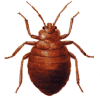|
|

|
Bed Bug pest control methods |

|
| Bed Bugs are blood-suckers commonly found in motels, hostels
or boarding houses where itinerant travelers stay overnight. Bed bugs
are often found in buildings used to store second-hand furniture or clothing.
How do Bed Bugs get into bed? Bed bugs are transported with luggage, clothing and other articles, but not on the person. It is not possible to know if someone is a ‘bed bug carrier’. Bed Bugs do bite ... at night. Next morning you may see dots of blood in a line on bed linen. The blood has a sickly sweet odor. Also look for dried blood deposits around cracks in the bed, bed-head, flooring, bedside furniture and mattress. Bed bugs life cycle: From the egg, the bed bug has five nymphal stages before becoming an adult. The adults and nymphs leave their harborage area to feed every 2 to 3 days. They feed for 3 to 5 minutes at night, in the early morning hours, before returning to their harborage area, usually located within a few meters from their feeding area. Bed bugs can survive for long periods without a blood meal. Adverse skin reactions: Some people have an adverse skin reaction to the bite of bed bugs. The bed bug injects an anti-coagulant chemical into the bloodstream of it's host which prevents the blood from clotting. This allows the bed bug to suck out the blood until it is fully engorged. NOTE: The resulting irritancy of the anti-coagulant chemical around the bite site can be severe, particularly to people with soft sensitive skin. Scratching is difficult to resist but this can cause infection of the bite area. If this is a likely problem, you should consult a doctor or chemist to obtain appropriate medication. |
| Pest Control for Bed Bugs |
| A professional pest controller should be engaged
to ensure safe effective control of a bed bug infestation. Firstly, a thorough
inspection of the area of infestation is carried out before proceeding
with control procedures. All potential daytime harborage areas
must be located and treated with an insecticide registered
for this purpose.
Do NOT attempt do-it-yourself pest control using a surface spray on bed-linen or mattress. Such a use could be a DANGER to the health and safety of the occupants. The pest management professional can use specialized equipment with a variety of insecticide formulations depending upon the circumstances. We recommend the safer synthetic pyrethroid insecticide dust or spray be used in certain locations. In addition, the entire area may require treatment using a fogging machine in order to achieve a satisfactory result. What You Can Do: All clothing, bed linen, curtains, fabrics, hangings and the like must laundered prior to insecticidal treatment. Wrap mattresses in black plastic bag and place in the sun for several hours. Seal gaps in furniture, floor boards and cracks in wallpaper and other such areas where bed bugs can hide during the day light hours. High standards of sanitation and hygiene, helps as an on-going preventive measure. The entire premises should be inspected regularly for signs of bed bug infestation. Prevention of a severe bed bug infestation throughout an entire building is more likely if regular attention is provided. Use a professional pest controller for periodic insecticide treatment in any commercial lodgings situation where bed bug infestations are likely to be a problem. |
| Learn about other common household pests |
| Ants | Borers | Silverfish | |||
 |
Bed Bugs | Roaches | Spiders | ||
| Bees | Fleas | Termites | |||
| Bird Control | Rats & Mice | Wasps |
| Find out how to protect Your Home from termites |
            |
| |
| Published by Fumapest Group © copyright 1995 - 2006 updated: |